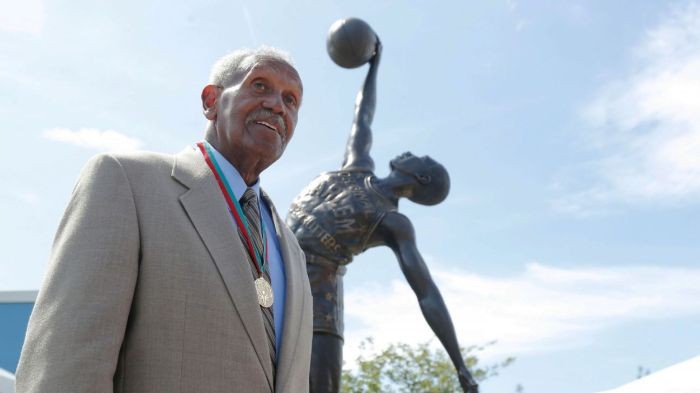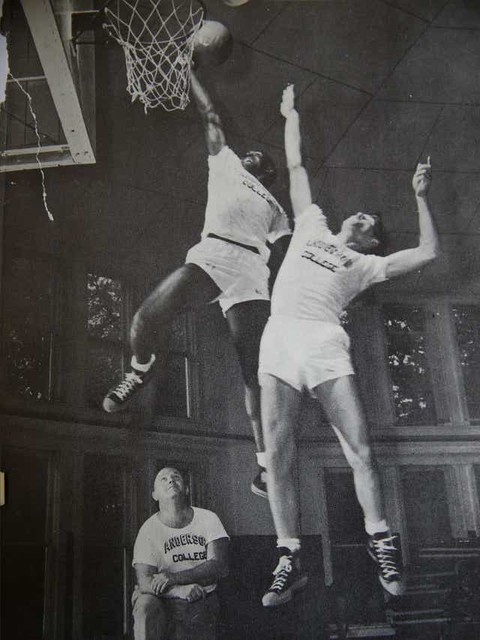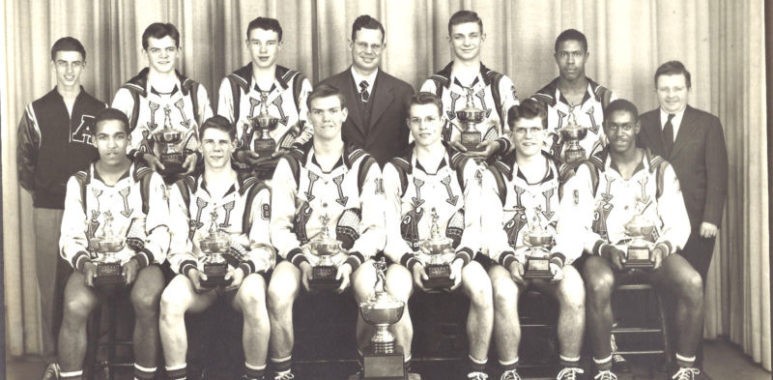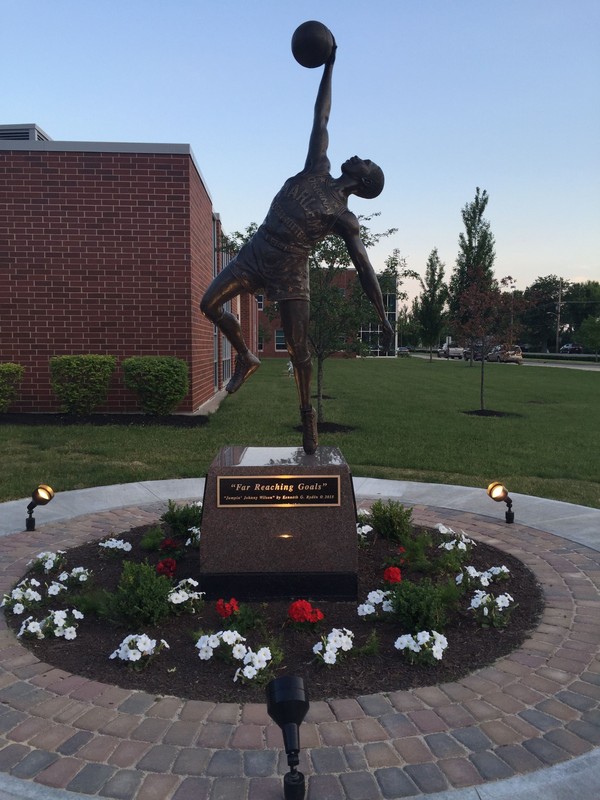Jumpin' Johnny Wilson Statue
Introduction
Text-to-speech Audio
Images
Jumpin' Johnny Wilson with the statue in the background

Jumpin' Johnny Wilson dunking at Anderson College

The team that won the 1946 State Championship (Notice Wilson is the only Black Player)

Johnny playing at AHS

Statue of Jumpin' Johnny outside AHS

Backstory and Context
Text-to-speech Audio
Born in 1927, Johnny Wilson became an extraordinary basketball player. Wilson was so skilled that he started for the sixth-grade team while he was still in fourth grade. He also became a standout player in the City of Anderson, and was regarded as a once--in-a lifetime talent. However, owing to his race, the starting position that should have been granted to him was denied by leaders of his high school owing to his race.
Wilson was introduced to racial injustice on the court when he was ten years old. His coach at the time said: “Johnny, you know in order for you to ever play ball at the high school, you’ve got to be twice as good as any white boy on the team.” His coach instructed him to play defense in a way that would make it difficult to call a foul, recognizing that many referees might be racially biased. Similar to the added burdens faced by other Black players, Wilson also coached to accept unequal treatment from players, fans, and coaches. Wilson became the leading scorer in the city with 240 total points as a young player, more than double the next player who had 99 total points.
By the 1940s, basketball had become one of America’s most popular high school sports, and Indiana was the game’s epicenter. With no professional sports teams or major state universities in the area, high school basketball filled the void for many rural Indiana communities. With limited opportunities to watch sports on television or travel, high school basketball was the highest level of sports competition most residents had the chance to watch. The state's large high school basketball tournament later became the model for the NCAA tournament, including a “Sweet Sixteen” and “Final Four.” In 1947 total attendance at the state tournament was nearly 1.25 million people. This was more than the combined attendance of nearly every major sporting championship in 1947, including the World Series, Rose Bowl, Orange Bowl, Cotton Bowl, Sugar Bowl, Indianapolis 500, Kentucky Derby, NCAA and NIT College basketball championships. (Graham and Graham-Cody 43).
When Johnny started high school, Charles Cummings was the basketball coach. As a result of the magnitude of high school basketball in Indiana, the desire to win, and his desire to acceptance all players regardless of race, Cummings made it clear that he would use the best players at his disposal even though many area residents opposed the idea of racial integration on the court. Beginning his sophomore year, Johnny was a regular starter on the basketball team. Wilson was the only player on the basketball team who could dunk even though he was barely 6 feet tall. As a result, he got the nickname Jumpin’ Johnny Wilson.
Wilson proved to be a critical asset to the Anderson High School Indian’s run to the state title in 1946. He was the star in every game on the way to the final, even though in the semi-state game he fouled out while playing defense against sharpshooter, Joe Keener. In the finals game, against the Fort-Wayne Central Tigers Wilson scored 30 points—breaking the record for the most points in a game— in a 14 point victory. The final score was 67 to 53. After his extraordinary leadership and skill that led to an Anderson state title, he was named Indiana Mr. Basketball for the 1946 season. Because of the magnitude of the Indiana State High School basketball tournament, College recruiters were at the final game. However, they did not recruit the star player, but rather his white teammates. Wilson learned very quickly that he would not be able to play for his dream college, the Indiana University Hoosiers, because of the color of his skin.
Since he was unable to play at his dream college, he settled for a starting spot on the newly formed Anderson College Basketball team. Wilson still holds Anderson College (University) records today. His career scoring average was 23.3 points, and his highest season scoring average was 25.4. He still ranks 8th all-time career scoring list with 1,540 points. During his career at Anderson College, he scored thirty points against NC State and the University of Cincinnati. Although Anderson College did not win those games, he caught the attention of fans on both sides of the court. Even though he was the star player at a very inclusive college he still had racial barriers to overcome, racial slurs were yelled at him during most away games. The Anderson College Raven’s qualified for the NAIA Small College Tournament during Wilson’s sophomore and junior years, but the team was unable to play because of their integrated team.
Following the trend of his career, Johnny was not able to play in the National Basketball Association (NBA) because of the color of his skin. Therefore, he played for the Harlem Globetrotters. He perfected the Globetrotter’s famous clowning routine. He could kick a basketball into the basket with extreme accuracy. Instead of playing professional basketball where he would have been very successful, he was relegated to clowning around with the other skilled Black basketball players who were not able to break the professional basketball color barrier. The highest level of competitive basketball he ever played was at the NAIA collegiate level. After retiring from the Harlem Globetrotter’s he became the head coach of Crane Community College (later renamed after Malcolm X) in Chicago. During his 16 years of coaching, he boasted a record of 375 wins to 178 losses.
In 2016, a statue of Jumpin’ Johnny Wilson was unveiled outside Anderson High School. The statue recognizes the injustice Wilson faced as well as his accomplishments on and off the court as he paved the way for the desegregation of Indiana High School Basketball. After the success of a Black player on Anderson’s team the next season, Shelbyville High School won the Indiana Basketball tournament with three Black starters. One of those starters was Bill Garrett who went on to integrate Big 10 Basketball. While Wilson was never given the same opportunity, his role as a coach and role model is recognized by this statue. Wilson died at age 91 in January of 2019, but was able to attend the dedication of this statue and expressed his hope that it would inspire more athletes of color.
Sources
Callen, Barry. The Guide of Soul and Mind: The Story of Anderson University. Anderson, Indiana. Warner Press, Inc, 1992.
Cramer, Karin. "Tourney time recalls Anderson's titles." Herald Bulletin (Anderson) April 7th 2012.
Graham, Tom. Graham-Cody, Rachel. Getting Open: The Unkown Story of Bill Garrett and the Integration of College Basketball. New York, New York. Atria Books, 2006.
Hirsch, Stuart. "'Jumpin' Johnny Wilson sculpture unveiled at AHS." Herald Bulletin (Anderson) May 27th 2016.
Knight, Don. "Passing of a Legend: Anderson legend Jumpin' Johnny Wilson dies at age 91." Herald Bulletin (Anderson) January 19th 2019.
Strege, Merle D.. The Desk as Alter: The Centennial History of Anderson University. Anderson, Indiana. Anderson University Press, 2016.
https://theundefeated.com/features/jumpin-johnny-wilson-refused-to-be-defined-by-injustices-in-athletic-career/
Indy Star Newspaper
http://northcentralconference.net/2016/03/16/andersons-indians-crowned-1946-state-champs-70-years-ago-today/
Herald Bulletin
Indy Star
